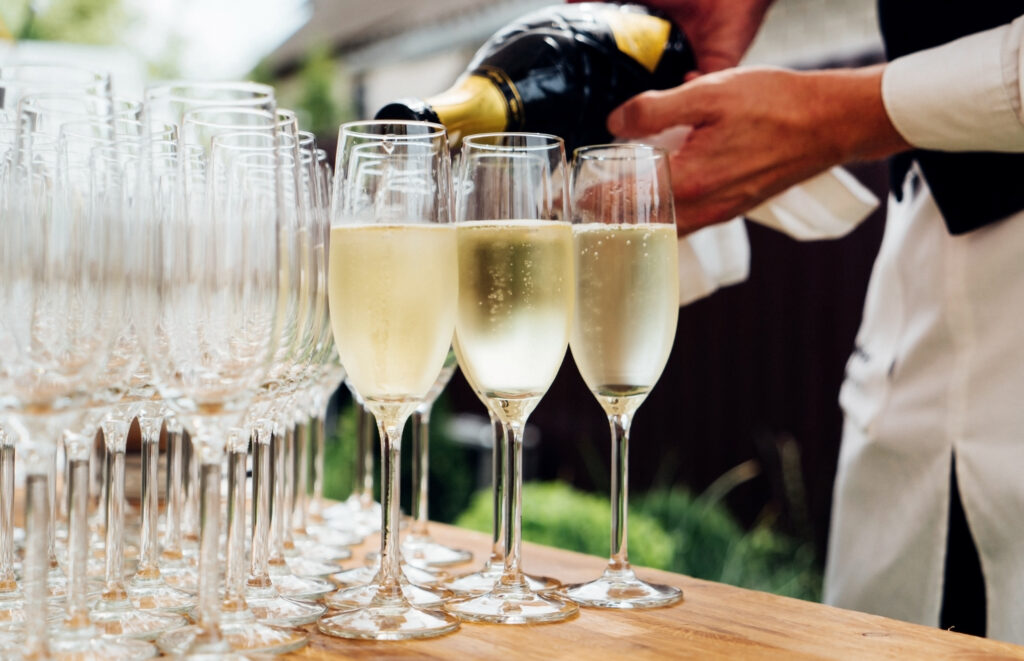Champagne is a sparkling wine which is produced in France. Specifically, it is only true Champagne if it comes from a specific region in France called Champagne; otherwise, it should be referred to as sparkling wine.
Champagne undergoes specific processes that give it distinct flavors, though the complexity of these flavors alters depending on how long Champagne spends on lees. This process creates flavors that are similar to toast, biscuit, or brioche.

While all Champagne is sparkling wine, the reverse is not true and not all sparkling wines are Champagne.
In the EU it’s illegal to use the term “Champagne” if the sparkling wine has not been produced in Champagne; however sometimes the term “champagne” is used in many countries to describe sparkling wines not made in the Champagne region, but in these instances, the lowercase form of the word should always be used.
Making Champagne
There are strict regulations for making Champagne.
The region features limestone and chalk soils and is situated quite far north in France, all of which contributes to wines with high acidity which is good for making high-quality sparkling wines.
Most of the grape varieties used for creating Champagne are either Pinot Noir, Pinot Meunier, or Chardonnay.
Once the primary fermentation process is complete, different wines may be blended together in order to create a consistent flavor and style.
This can involve combining wines of different vintages, from different vineyards, and from different grape varieties to create consistency in flavor over many years.
While it’s not true for every Champagne producer, certainly many Champagne producers want to create a house style that consumers can trust will be fairly consistent from one year to the next.
The wines are bottled before yeast cultures and cane sugar are added and the bottle is sealed for the second fermentation process to begin.
This takes usually up to three weeks and then the bottles are placed on their side to rest on the lees.
Creating complex flavors and textures
Lees refers to the dead yeast cells that are left in the bottle after fermentation has ended.
There are both gross lees and fine lees, and while gross lees are usually removed after fermentation, fine lees can be left in for a certain period of time in order to influence the flavor of the wine.
Gross lees are larger sediments that tend to settle on the bottom of the bottle, whereas fine lees are finer particles that take longer to settle.
They can be filtered out but this would result in a wine with less complex flavors.
It is law in France that a non-vintage Champagne has to be aged for 15 months after bottling, with at least 12 months on lees.
Vintage Champagne requires at least three years of aging on lees; however many Champagne producers choose to leave their top-quality wines (both vintage and non-vintage) on lees for much longer.
During this period the wine undergoes autolysis, which is a process where the dead yeast cells are broken down by their own enzymes and this causes amino acids, proteins, and carbohydrates to be released into the wine.
This process creates a creaminess and richness in the wine and also creates flavors like toast, bread, biscuit, and brioche.
The lees will eventually be removed through a disgorgement process before a small amount of Champagne is added to the bottle in order to replace the amount lost through disgorgement.
This added Champagne also has a certain amount of sugar in it that will affect the sweetness level of the wine.
Using all the senses
Enjoying Champagne is a process that should involve all the senses in order to fully appreciate the sparkling wine.
From the sound of the cork being removed from the bottle and the Champagne being poured into a glass, to the color of the sparkling wine, the appearance of the bubbles and the nose.
The nose refers to the way the Champagne smells such as floral, fruity, or spicey, and these aromas can vary greatly from one bottle to the next, as well as depending on how the individual perceives them.
When tasting the Champagne, you may taste citrus, peach, or cherry flavors, perhaps even almond flavors in addition to toast or biscuit-like flavors.
The term palate refers to identifying and tasting various wine characteristics and can cover not just specific flavors but how the wine feels inside the mouth, such as delicate or velvety.
Using all the senses will elevate the appreciation of Champagne and help to distinguish subtleties in its taste.
